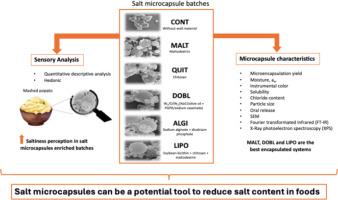Development of sodium chloride microcapsules as saltiness enhancement strategy
IF 5.1
Q1 CHEMISTRY, APPLIED
引用次数: 0
Abstract
This study aimed to develop salt microcapsules using different wall materials to achieve stable encapsulated salt systems with optimal water solubilization and controlled salt release in the oral cavity, leading to an acceptable saltiness perception in food matrices. Six types of salt microcapsules were prepared, uncoated salt (CONT) and coated with maltodextrin (MALT), chitosan (QUIT), double emulsion (DOBL), alginate (ALGI), and liposomes (LIPO).
Significant differences were observed in size distribution, intermolecular forces, solubility index, salt release during oral digestion, and sensory evaluation. MALT microcapsules exhibited the most homogeneous size distribution, while ALGI showed the smallest particle size (D(4.3) = 0.27 μm). QUIT and DOBL microcapsules demonstrated the strongest intermolecular interactions between Na+ and Cl− ions and their respective wall materials, giving the lowest solubility (77.95 and 58.74 %) and oral salt release values (39.51 and 45.87 %). Contrarily, CONT, MALT, ALGI, and LIPO microcapsules exhibited higher solubility (99.77, 90.33, 92.65 and 86.01 %) and salt release (96.62, 83.08, 88.22 and 86.01 %).
Sensory analysis revealed that coated salt microcapsules enhanced the perception of saltiness compared to uncoated samples, demonstrating the potential of salt encapsulation as a strategy to reduce overall sodium content in foods without compromising taste. However, QUIT and ALGI microcapsules received the lowest hedonic scores, possibly due to undesirable sensory attributes associated with their wall materials.
Overall, MALT, DOBL, and LIPO microcapsules emerged as the most promising formulations, offering a balance of favorable characteristics across multiple parameters and highlighting their potential application in the development of reduced-sodium food products.

氯化钠微胶囊增盐策略的研制
本研究旨在利用不同的壁材开发盐微胶囊,以获得稳定的胶囊化盐系统,具有最佳的水溶性和控制盐在口腔中的释放,从而使食物基质具有可接受的咸味。制备了无包被盐(CONT)和包被麦芽糖糊精(MALT)、壳聚糖(QUIT)、双乳(DOBL)、海藻酸盐(ALGI)和脂质体(LIPO)的6种盐微胶囊。在大小分布、分子间力、溶解度指数、口腔消化时的盐释放和感官评价等方面观察到显著差异。MALT微胶囊粒径分布最均匀,ALGI微胶囊粒径最小(D(4.3) = 0.27 μm)。QUIT和DOBL微胶囊的Na+和Cl−离子与各自壁材的分子间相互作用最强,溶解度最低(77.95%和58.74%),口服盐释放值最低(39.51%和45.87%)。相反,CONT、MALT、ALGI和LIPO微胶囊的溶解度分别为99.77%、90.33%、92.65%和86.01%,盐释放度分别为96.62%、83.08、88.22%和86.01%。感官分析显示,与未包覆的样品相比,包覆盐微胶囊增强了对咸味的感知,这表明盐包覆作为一种降低食品中总钠含量而不影响味道的策略的潜力。然而,QUIT和ALGI微胶囊获得的享乐分数最低,可能是由于与壁材料相关的不良感官属性。总的来说,MALT、DOBL和LIPO微胶囊是最有前途的配方,在多个参数中提供了有利特性的平衡,并突出了它们在低钠食品开发中的潜在应用。
本文章由计算机程序翻译,如有差异,请以英文原文为准。
求助全文
约1分钟内获得全文
求助全文

 求助内容:
求助内容: 应助结果提醒方式:
应助结果提醒方式:


